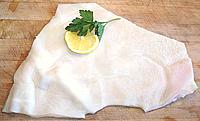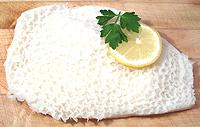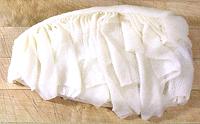Beef Tripe
A cow has four stomachs. The stomach walls of the first three are commonly
sold as "tripe" and the fourth less commonly so. Some Americans hold tripe
to be disgusting, but there are many famous recipes for it and its
popularity is world-wide.
The most famous American tripe dish is Philadelphia Pepper Pot,
said to have saved the American Revolution when Washington's army was
starving at Valley Forge. In keeping with other famous tripe soups and stews,
it should be made with a calf's foot. Mexican Menudo is perhaps the
tripe dish most familiar to Americans and is famed as a hangover cure (tripe
and calf foot have this reputation in a number of countries).
More on Beef Innards.
Buying:
Tripe tends to be rather rare in
chain supermarkets, but is very common in ethnic markets serving Asian,
European, Mexican, South American, and Near and Middle Eastern
communities. A specialty meat market should also be able to supply it.
Unlike the tripe described in older cookbooks, that sold in North
America today is thoroughly cleaned, parboiled and bleached, so it's
pretty much ready to go. As purchased, it should have almost no odor.
Buy the type of tripe appropriate to your recipe. Generally rustic
recipes are happy with Blanket Tripe, the more refined prefer Honeycomb
Tripe. Book tripe is not so commonly used but has a unique texture and
mingles well with sauces.
A cow has four stomachs, each providing a distinct form of tripe:
Blanket Tripe
, also known as flat or smooth tripe, double
tripe (obsolete) or gras double (French), comes from the first stomach,
the rumen. This is the lowest cost tripe and is fine for most soups and
stews.Honeycomb Tripe
comes from the second stomach, the
reticulum. It is preferred for more delicate dishes or where holding
sauces well is desired.Book Tripe
, also known as leaf or bible tripe, comes from
the third stomach, the omasum. It is less common than the other two
but provides a unique double texture, thick and thin.Reed Tripe
comes from the fourth stomach, the abomasum, but
is rarely seen in American markets due to its glandular nature. It is
called for in some traditional Italian recipes.
Role Tripe
is an 18th century term no longer used and nobody
seems to know exactly what kind of tripe it designated.
Green Tripe
is tripe fresh from the cow and may be olive
green, gray or brown. In this condition it's ugly, crusty, smelly and
unappetizing, though dogs like this form best. Cleaning green tripe is
a real hassle and is described in cookbooks from early times. The tripe
sold in North American markets has already been thoroughly cleaned so
you don't have to do that, unless you're disassembling your own cow.
Yield:
You will end up with less than half the
weight you started with, as little as a third for honeycomb tripe. Recipes
should give the starting weight unless explicitly stated otherwise, such
as calling for "cooked tripe". Unfortunately many cookbook writers are
very sloppy about things like this - they presume the whole world does
everything the exact same way they do (British cookbooks are particularly
bad this way). If there are no instructions to cook the tripe in the
recipe, its a good bet the weight is for already cooked tripe.
Cooking Procedure:
- Rinse the tripe thoroughly and remove any fat that may be attached
to it.
- Place the tripe in a pot with cold water to cover. Add some
Citric Acid or Lemon Juice to the water along with a
teaspoon of salt. Bring to a boil for a few minutes, then drain and
rinse the tripe.
- With fresh water, acid and salt, repeat the above step.
- Clean the pot. Return the tripe to the pot and add fresh cold water
to cover. Bring to a boil and and simmer until tender but still
"al dente", especially if it will be cooked much more in the recipe.
Caution: Sample the
tripe as it cooks, because cooking time depends not only on type, but
also on degree of pre-processing. Tripe I've purchased from a large
Hispanic market in Los Angeles (Burbank) required rather short
cooking. Normal cooking for cleaned and par-boiled tripe (as usually
sold here in Southern California) is about 2-1/4 hours for Blanket
Tripe down to 1-1/4 hours for Book Tripe. It should still be a bit
chewy, but not too much.
- Cut the tripe to whatever size and shape the recipe calls for.
I've read complaints about the odor of cooking tripe on Internet
discussion boards. I don't know where they got their tripe, but that we
have in Southern California has almost no odor as purchased and only a
light and not unpleasant odor when cooking.
ab_tripez 070825 r 100509 - www.clovegarden.com
©Andrew Grygus - agryg@clovegarden.com - Photos
on this page not otherwise credited © cg1
- Linking to and non-commercial use of this page permitted





